Chapter 5.
OSIRIS.
1. EGYPT – ANCESTRAL CEMETERY OF THE ROYAL DYNASTY WHICH ANDRONICUS-CHRIST BELONGED TO.
In our previous works we have repeatedly pointed out that African Egypt was a burial place of the kings of the Great Empire. Moreover even at the time when its capital was already situated very far from the Nile’s valley, i.e. at first in Czar-Grad on the Bosphorus and later in Vladimir and Suzdal Russia.
In 2000-2003 we succeeded in decipher a considerable amount of the ‘Old’ Egyptian zodiacs and calculate the dates recorded on them. In particular we have dated the burials in the Valley of the Kings, and also the zodiacs situated on the ceilings of the mortuary temples scattered around it. The picture of the dates we’ve obtained is rather interesting. It turned out that the majority of the dates referring to the royal burials of the Valley of the Kings point at the XII-XIII cc. A.D. See our books ‘Novaya Khronolgiya Yegipta’ (‘The New Chronology of Egypt’), 2 edition, p.459 and ‘Kazaki-arii: iz Rusi v Indiyu’ (‘The Cossacks-Aryans: from Russia to India’), p.454.
Moreover many of the obtained dates correlate well with the milestones of the dynastic Byzantine history of the same epoch. First of all we shall point out the Osiris Zodiac, Circular Denderah Zodiac, which as we have already said, gives the exact date of the paschal full moon at the crucifixion of Christ – the morning of the 20th March 1185. See above fig.1.32 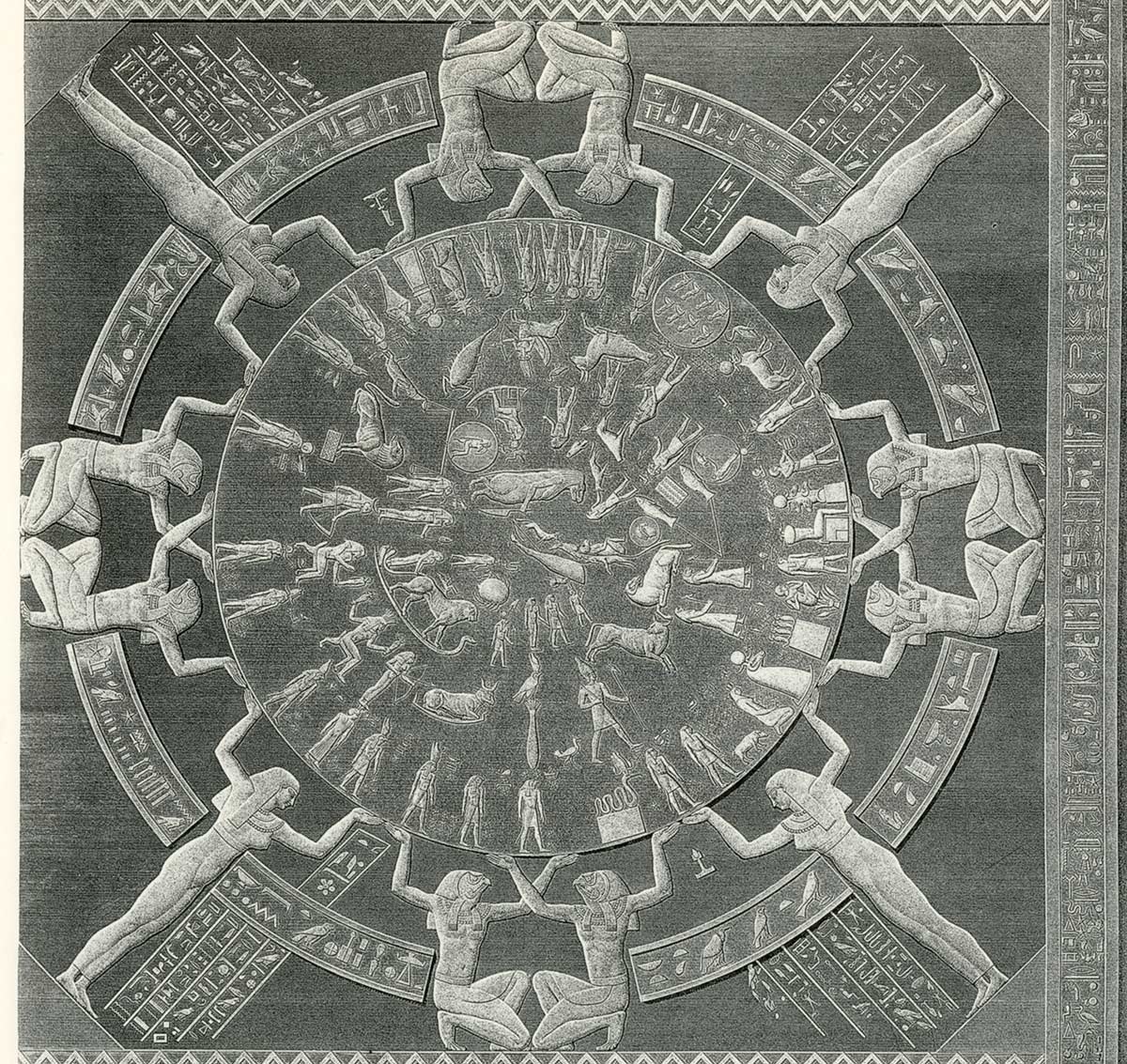 .
.
In addition, Zodiac of Ramesses VII corresponds with the end of the reign of Alexius II Comnenus – the immediate predecessor of Andronicus-Christ. Namely, 5-8 September 1182 A.D. See illustration Ц15 in our book ‘Novaya Khronolgiya Yegipta’ (‘The New Chronology of Egypt’), 2 edition, 2003.
King Seti I Zodiac gives us the year of 1206, i.e. probably the year of the death of Isaac Angelos. The exact year of his death in the Byzantine history is unknown, but Nicetas Choniates reports, that in 1204 Isaac was lying on his death bed [141], p.241. Choniates does not specify when exactly Isaac Angelos died. But in 1206, after the rebellion, the reign of the Latin Emperor Henry of Flanders begins in Czar-Grad [19], [88]. See the depiction of King Seti I Zodiac in illustration Ц31 in our book ‘Novaya Khronolgiya Yegipta’ (‘The New Chronology of Egypt’), 2nd edition, 2003.
One more date which corresponds well with the end of the reign of the Byzantine emperor. We are referring to Commagene Zodiac in South East Turkey, on which there is recorded the date: the morning of the 14th September 1221. But 1221 is precisely the year of Theodore Laskaris’ death. We know from the Byzantine chronicles that he died in either 1221 or 1222 [140]. The depiction of the Commagene Zodiac is in illustration 2.72 in our book ‘Kazaki-arii: iz Rusi v Indiyu’ (‘The Cossacks-Aryans: from Russia to India’), 2004.
The idea that the discovered parallels are not random is strengthened by the fact that the ‘Ancient’ Egyptian burial Zodiacs in the Valley of the Kings and the Lion of Commagene do not give any other dates in the given epoch besides the mentioned ones: 1182, 1206, 1221. Note, that the Lion of Commagene is also the royal burial zodiac as are the zodiacs from the Valley of the Kings. Incidentally the burial place in which it is situated is one of the largest burial complexes in antiquity. It is thought that it is there that King Antiochus I is buried [34], p.153.
This fact proves an idea suggested by N.A.Morozov that the burial sites of the Egyptian pharaohs are the burial sites of the Byzantine emperors. Our analysis showed that the more recent Egyptian burial sites date to the epoch of Vladimir and Suzdal Russia. But in the XII-XIII cc., i.e. before the formation of the Great = ‘Mongol’ Empire, they used to bury Czar-Grad and Nicaean emperors who ruled in the Bosphorus in the Nile Valley. In particular the Comneni. Moreover, since we have found the parallels between Andronicus Comnenus, Andrei Bogolyubskiy and Christ, it follows that in the Kings Valley there are situated the tombs of Andronicus-Christ’s closest relatives.
After the formation of the Great = ‘Mongol’ Empire in the XIV-XVII cc., the bodies of the deceased great Hordian czar-khans who died in Russia were as before embalmed and moved to the old ancestral cemetery in Egypt. The vague information about it survived despite the Romanov cleansing of the sources. For example Isaac Massa, the eyewitness of the Moscow events of the early XVII century wrote that when in Moscow they allegedly burnt the dead body of Czar Dmitriy Ioannovich the ‘Imposter’ the Muscovites disapproved of it and ‘said that IT OUGHT TO BE EMBALMED’[91], p.132. I.e. according to the Muscovites of the XVII century the bodies of the Russian czars were supposed to be embalmed. What for, one may ask? To bury the bodies in the ground, as they do now, the embalming is unnecessary and pointless. That is why no one does that. Even when it comes to the czars. Embalming is necessary in order to keep the body not in the ground, but for example in a sarcophagus, a tomb or a mausoleum. But as we know there were no mausoleums built in Russia in the past. In our opinion the bodies of the Russian czars were embalmed in order to be transported to Egypt, to the ancestral ‘Mongolian’ cemetery of Russia-Horde.
Some vague references to such a custom remained in Nicetas Chonates work. Thus for example when describing emperor John Comnenus he reports: ‘After paying his last respects to his father, the king put his body ONTO ONE OF THE SHIPS, standing on the river Pyramus, which irrigated Mopsuestia and flowed into the sea’ [140], p.63. Nothing else is said about the obsequies in Czar-Grad, in Byzantium itself. And in another place: ‘Passed away … Alexius, the first-born of the brothers and the heir to the paternal power; followed by Andronicus, second after the first; he also soon after that completed his life, after BRINGING THE BODY OF HIS DEAD BROTHER (COUSIN) FROM OVERSEAS’ [140], p.62.
In both cases a clear connection between the burial and the sea reverberates. The body is put onto a ship. Andronicus is bringing the body of his dead BROTHER (COUSIN) from overseas. It is possible of course to interpret these actions in different ways. Nevertheless, it is odd, that having started speaking about the burials, Choniates doesn’t say anything about the burial ceremony, the splendid procession, etc. He only mentions the TRANSPORTATION OF THE BODY ON THE SHIP ACROSS THE SEA. If the bodies were carried to Egypt, then Choniates’ words become clear. The king dies, the coffin with his body is put on a ship and is sent far away across the sea. The king’s sonescorts the body across the sea.
The name of the river, where the ship with the John Comnenus’ body stood is very interesting – PYRAMUS. Today there is no river with such a name. The commentators think that it is the the Ceyhan River of present day Turkey [140], p.366. As we begin to understand now in fact they referred here to the NILE flowing past the pyramids. That is why on the pages of ‘Historia’ by Choniates there remained the word PYRAMUS, which turned into a river’s name. It becomes clear why Choniates highlights that the river ‘Pyramus’ IRRIGATES the land around it. Of course any river irrigates its surroundings, but it is the Nile which stands out by literally irrigating the vast neighboring lands and makes them fertile.
Now it is interesting to see how the ‘ancient’ Egyptian tombs are painted and what is depicted there. They can tell us a lot about the epoch of Andronicus-Christ and about himself. Clearly, Christ himself should be present in these images. Of course today some of the images of ‘Ancient’ Egypt seem to us very far from the Christian tradition we are accustomed to. But we must not forget that we are dealing with a very old custom. And it was a funerary tradition of the royal family in particular, which not necessarily reflected the generally accepted norms of that time. Egyptian Valley of the Kings was situated in an inaccessible place which was closely guarded. No outsiders were allowed there. The burial complex was serviced by the people who lived there their whole life and virtually never communicated with the rest of the world of the Empire. This explains the significant isolation of the funerary symbolism of the Valley of the Kings from the empire-wide culture.
In addition the royal burial sites in the Valley of the Kings dated by us, - the last of which can be attributed to the middle of the XIV century, - fall on the epoch preceding the adoption of Christianity in the Empire in the late XIV century. Of course in the royal family for Andronicus-Christ was a relative of Christianity which had existed before, but in a significantly different form than today. It was so to say a familial, clan religion. His relatives perceived the story of Andronicus-Christ differently from us. For them it was a story of their family, in which almost all the characters, including the antagonistic ones, were family. Naturally such links made a strong impact, and coloured their perceptions.
In the XIV-XV cc. together with the adoption of the Christianity all of this became a thing of the past. A lot of things have changed in the Empire, Christianity became a single faith for those in power and for the common people. Further we will briefly talk about how all of this was taking place and will give a detail description of it in our successive books. Here we shall address the ‘Ancient’ Egyptian myths and images in order to retrieve from there those stories about the life of Christ, which were preserved in the royal family in the epoch of the XIII-XIV cc.
In Egyptian culture Christ is represented as Osiris. Here is what we know about him.
2. THE HOLY HISTORY IN THE ‘ANCIENT’ EGYPTIAN LIGHT.
‘Originally the Egyptians perceived Osiris as a man who lived like them on Earth, needed water and food, suffered a brutal death, but with the help of the gods won a victory over it and attained immortality’ [11], p.49. The Egyptian Osiris <<was proclaimed to be ‘born by the heavens, be a descendant of Nut, flesh and bones of Geb (Seb) (Sabaoth, Holy Father (God the Father) ? – Aut.)’ >>, p.49.
The modern researchers draw their information about the ‘Ancient’ Egyptian religion mainly from the following sources. Firstly, there is extant Plutarch’s writing on Isis and Osiris in Greek. However the historians treat it with caution. According to their opinion it contains a lot of mistakes: ‘Plutarch identifies some of the Egyptian deities with the Greek ones and includes numerous claims in the text which are the result of his own imagination and the consequence of the inaccurate information’ [11], p.39. But some of the alleged mistakes may be the result of the confusion not of Plutarch but the historians themselves. Though, certainly the mistakes of Plutarch cannot be ruled out.
Furthermore, in addition to Plutarch the researchers have at their disposal numerous Egyptian images and texts. However, in regards to the ‘Ancient’ Egyptian texts, the task of translating them into the modern languages is quite complicated. Regardless the hieroglyphs the meaning of many ‘Ancient’ Egyptian terms still remains unclear. That is why the modern translations of the hieroglyphs and the papyruses are rather opaque. Sometimes they can be even contradictory. For example, when describing one of the ancient papyruses Egyptologist E.A.Wallis Budge was compelled to declare that allegedly ‘the Egyptian scribes did not understand very well what they were writing’ [11], p.28. But most likely the problem was not in the ignorance of the scribes, but in the modern commentators being unable to fully understand the meaning of the authentic ‘Ancient’ Egyptian texts. Therefore their translations should be treated with caution. To a large extent they are just a certain interpretation of the material not entirely clear to their translators.
The similarity between the Egyptian god Osiris and Christ is so obvious that many researchers pointed it out. Moreover, this fact was also well known in the Mediaeval Christian tradition. The correspondence between Osiris and Christ embraces nearly all the salient points of the doctrines of Christ. In addition, many other statements in the Bible and ecclesiastical traditions are also reflected in the ‘Ancient’ Egyptian myths. Let us take a quick look at the discovered parallels. We will make use of a book by Egyptologist E.A.Wallis Budge called ‘Egyptian religion. Egyptian Magic’ [11], where in quite a lot of detail the modern commentators’ knowledge about the Egyptian gods was presented. We shall stress once again that this knowledge cannot be considered absolute. For the modern historians the Egyptian religion is ‘the dead religion’, known allegedly only by its old images and texts, the full understanding of which is absent today. Nevertheless the main points most likely are understood correctly, though there might be errors in the details.
1) THE CREATION (OF THE WORLD) ACCORDING TO THE BOOK OF ‘GENESIS’. To recall the description of the creation of the world in ‘Genesis’. The first words go as follows: ’In the beginning God created the heaven and the earth. And the earth was without form, and void; and darkness was upon the face of the deep. And the Spirit of God moved upon the face of the waters’ (Genesis 1:1-2).
In essence the ’Ancient’ Egyptian sources tell us the very same thing. ‘According to the Egyptian texts there existed a time when there was neither the heavens, nor the earth, when there was nothing, but the boundless primordial waters shrouded by the thick darkness’ [11], p.27. Fig.5.1 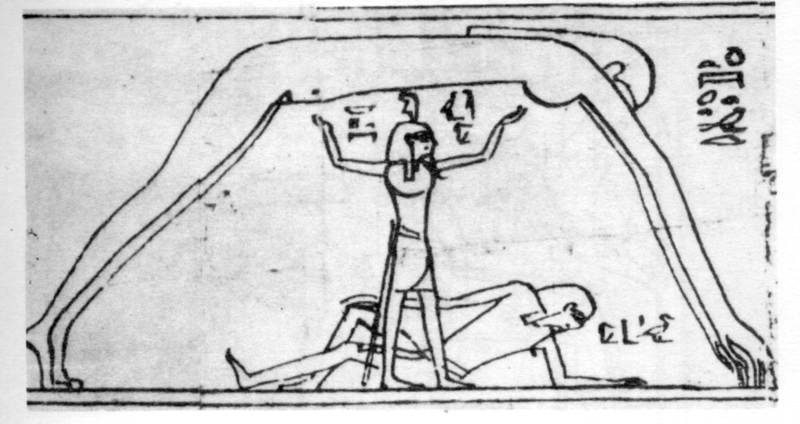 presents an ‘Ancient’ Egyptian image of the creation of the world. Fig.5.2
presents an ‘Ancient’ Egyptian image of the creation of the world. Fig.5.2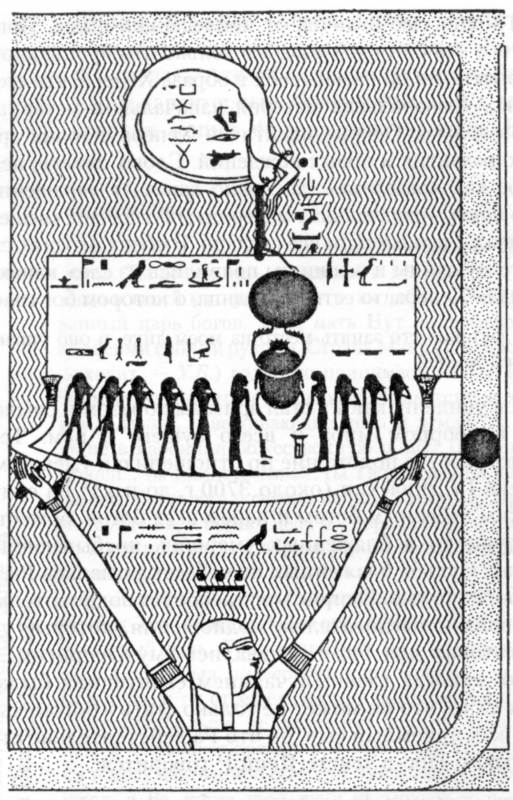 presents ‘the separation of the earth from the sky’. Fig.5.3
presents ‘the separation of the earth from the sky’. Fig.5.3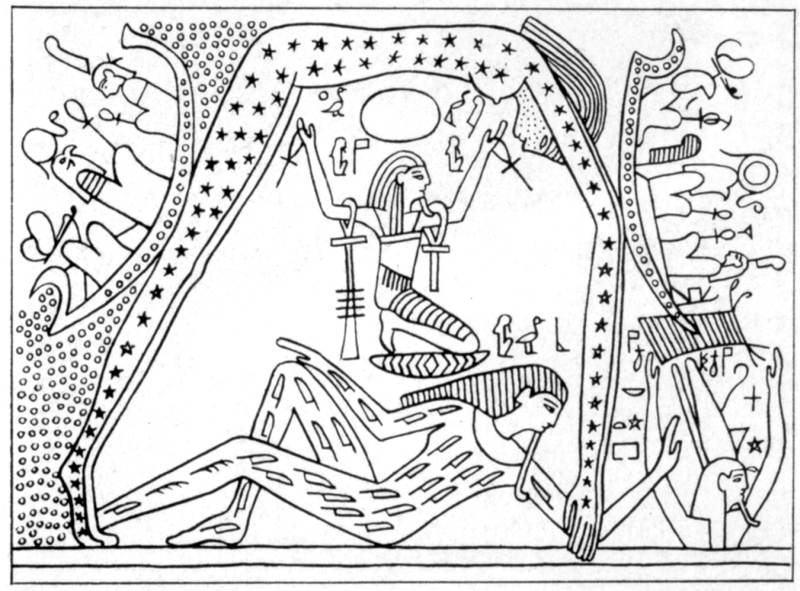 presents a more detailed version of the Egyptian myth.
presents a more detailed version of the Egyptian myth.
2) THE CREATION OF THE WORLD ACCORDING THE GOSPEL OF JOHN. John begins his Gospel with the following words describing the creation of the world: ‘In the beginning was the Word, and the Word was with God, and the Word was God. The same was in the beginning with God. All things were made by him; and without him was not any thing made that was made. In him was life; and the life was the light of men. And the light shineth in darkness; and the darkness comprehended it not’ (John 1:1-5).
We read literally the same thing from the ‘Ancient’ Egyptians. We shall continue the quotation from the Egyptian sources we interrupted above: ‘Finally, the spirit of the original waters felt the desire to create, and when it pronounced a word, the world immediately became incarnated in the form which had already existed in the spirit’s mind prior to it saying the word, which became the cause of the creation of the world’ [11], p.27.
The very same idea, also close to the Gospel of John is expressed in the so called Papyrus of Nesi-Amsu kept in the British Museum: ‘I developed the evolution of evolutions. I shaped my mouth, and I uttered my own name as a word of power, and thus I evolved myself under the evolutions of the god Khepera, and I developed myself out of the primeval matter which had evolved multitudes of evolutions FROM THE BEGINNING OF TIME. NOTHING EXISTED ON THIS EARTH BEFORE ME, I MADE ALL THINGS. There was none other who worked with me at that time. I created all the evolutions there with the Holy Spirit which I created myself … I … CREATED EVERYTHING THAT WAS CREATED… I … created a multitude of creatures … I gave birth to the gods Shuu and Tefnut, and being One I became Three! (! – Author)’ [11], p.28.
Here we see not only an almost literal retelling of the Gospel of John, but also a clear-cut doctrine of the Trinity. While we quote the Egyptian expressions dated by the historians to hundreds and even thousands years BEFORE A.D. The Egyptologists date the papyrus to the year 300 B.C., and consider the doctrine itself to be ‘much more ancient’ [11], p.28.
Faced with such an incredible parallelism we have only two possibilities. We can either assume that Christianity assimilated the earlier, most ancient Egyptian myths, which in fact exactly what the modern commentators are compelled to do under the pressure of the Scaligerian chronology. Or on the contrary we can suppose that the history of ‘Ancient’ Egypt is much more recent. The choice between the two stated possibilities can be made only based on the independent reliable dating. We obtained such dating for the history of Egypt in the book ‘Novaya Khronologiya Yegipta’ (‘The New Chronology of Egypt’ in Russian). Absolutely positively it follows that ‘Ancient’ Egypt is a mediaeval country, which already existed in the epoch of Christianity in the XII-XVI cc. The ‘Ancient’ Egyptian texts and imagery are in fact Christian. The Egyptian Christianity of course differed from the modern one. It was another, much older version of Christianity. Nevertheless it was definitely the Christian religion, in which Christ bore the name Osiris.
Once again, the modern translations of the Egyptian texts are quite dark and uncertain. The problem is, generally speaking the hieroglyphs cannot convey the meaning in the same way as modern language does. Reading of the old Egyptian texts presupposed the knowledge of various conventions, the knowledge of the material in general. If such knowledge is lost then the perception of the hieroglyphs becomes rather approximate and remote. The modern translations can be trusted only in general, but not in detail.
But if Osiris is Christ, then a natural question arises: did Christianity appear in Egypt from the very beginning of its most ’ancient’ history or later? The question is whether Osiris-Christ can be traced throughout all the old Egyptian texts or whether there is still a strand in the sources where he doesn’t exist?
The answer is: there is no such a ‘non-Christian’ Egyptian strand. Egyptologist E.A.Wallis Budge states: ‘IN ALL THE KNOWN PERIODS OF EGYPTIAN HISTORY the citizens of this country believed in the divine origins of OSIRIS, that he was maimed by the evil forces and suffered death after the long struggle with those forces, raised from the dead, having become the king of the underworld and the judge of the dead… In the most ancient funerary texts Osiris is credited the same status among the other gods as in the most recent copies of the Book of the dead. The first authors of the ancient hieroglyphic funerary texts and their more recent editors were convinced, that the story of Osiris is known to everyone’ [11], p.38.
At the same time the Egyptian researchers complain, that the Egyptian sources lack ‘a coherent narration about the life and worldly sufferings of this god’ [11], p.38. The story of Osiris is being restored based only on the fragments. In other words the ‘Egyptian Gospel’ has still not been found. Or they did not want to find it, in order not to exacerbate the already strong conformity with Christ.
Fig.5.4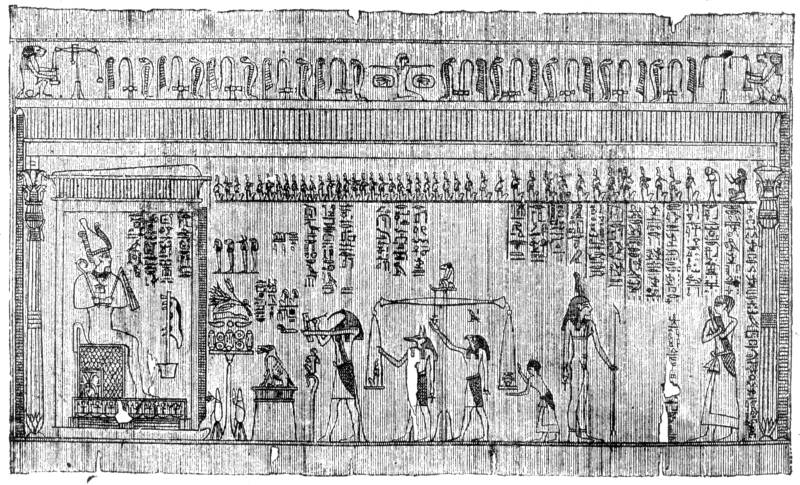 presents an ‘Ancient’ Egyptian depiction of ‘Judgment of a soul’ from the well-known ‘Book of the dead’. The god-judge Osiris sits on the throne, Anubis weighs the heart of the deceased on the scales, Thoth inscribes the sentence on the soul. In front of us there is a famous Christian concept of the Last Judgement, when in the presence of Christ-judge each person will be allocated a place either in heaven or in hell depending on his actions.
presents an ‘Ancient’ Egyptian depiction of ‘Judgment of a soul’ from the well-known ‘Book of the dead’. The god-judge Osiris sits on the throne, Anubis weighs the heart of the deceased on the scales, Thoth inscribes the sentence on the soul. In front of us there is a famous Christian concept of the Last Judgement, when in the presence of Christ-judge each person will be allocated a place either in heaven or in hell depending on his actions.
Fig.5.5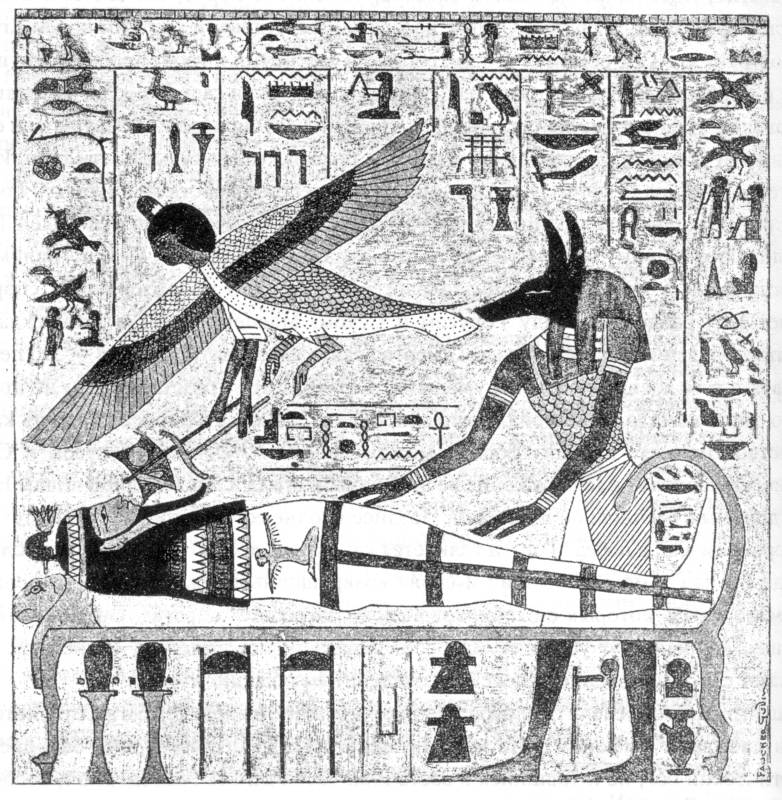 presents an ‘Ancient’ Egyptian image of the mummy of Osiris, prepared for the burial by Anubis.
presents an ‘Ancient’ Egyptian image of the mummy of Osiris, prepared for the burial by Anubis.
According to the ‘Ancient’ Egyptian beliefs ‘All the old religious centres were subjected to Osiris, he was given power over the gods and the people’ [86], p.75. Like Christ, god Osiris was called ‘One who defeated death’ ‘86], p.76.
3. THE BIRTH OF OSIRIS AND ETERNAL NATIVITY OF CHRIST. THE EPIPHANY.
To recall, according to the Christian teaching, as expressed for example in the Symbol of Faith, Christ was born before all times: ‘Begotten of the Father before all ages’ (The Symbol of Faith). In Christian literature there used to be an expression ‘born before dennitsa (the morning star)’ (Psalms 109:3). See also the work by Cosmas Indicopleustes [76], p.172, where it is explained that the word ‘dennitsa’ (Lucifer) means a star. And born before the dennitsa (morning star) – is Christ born of Father God before the creation of the stars. This refers to the biblical story about the creation of the world, when on the first day of creation in turn were created: the heavens, the earth, and after some time – the stars. ‘And God made two great lights; the greater light to rule the day, and the lesser light to rule the night: he made the stars also’ (Genesis 1:16). The so called ‘Gospel of Thomas’ (The Infancy Gospel) says: ‘Maybe he was born before the world came into being [62], p.224.
Thus the Christian tradition believes that the eternal Nativity of Christ took place when the Sun, the Moon and the stars were created.
The same is said about Osiris. Here is this vague Egyptian story in which the discernible biblical features can be clearly seen: ‘They tell that the Sun having discovered Rhea secretly copulating with Saturn, laid a curse upon her … that Hermes (Mercury)... playing at counters with the Moon and winning from her the seventieth part of each one of her lights, out of the whole composed five days, the which he added to the three hundred and sixty, which days now the Egyptians call "additional," and keep as the birthdays of the gods; that on the first of these was born Osiris, and that, A VOICE ISSUED FORTH WITH HIM IN THE BIRTH, THAT "THE LORD OF ALL IS ENTERING INTO LIGHT." But some relate it differently’ [11], p.39. Here in front of us is a mixture of different Christian beliefs. We should say straight away that the Egyptian text is quite muddled. In it there is entwined, for example, the biblical Days of Creation and the calendar and astronomical days, added to the 360 days lunar calendar in order to obtain a solar (Julian) calendar year. However in its more or less pure form this Egyptian story perfectly matches the church views on Christ. It is said that Osiris – i.e. Christ – was born on the first day of Creation. As we have already explained such an indication exactly corresponds with the Christian formula: ‘born before dennitsa (the morning star)'. Moreover this formula, as does the Egyptian story, elates the eternal birth of Christ-Osiris with the creation of the Sun, the Moon and the stars on the first day of Creation.
Further, here in the Egyptian text we can see a rather straight-forward correspondence with the Gospel Epiphany. To recall, that according to the Gospels Christ’s ministry began from the baptism by John the Baptist. ‘And Jesus, when he was baptized, went up straightway out of the water: and, lo, the heavens were opened unto him, and he saw the Spirit of God … And lo A VOICE FROM HEAVEN, saying, This is my beloved Son, in whom I am well pleased’ (Matthew 3:16-17).
Here the voice from the heaven proclaims the coming of Christ into the world and the beginning of his ministry. And the Egyptian papyrus tells us about a certain voice announcing the moment of Osiris’ coming into the world.
Another partial reflection of Christ-Andronicus in the ‘Ancient’ Egyptian sources is god Horus born by Isis. There are known many ‘Ancient’ Egyptian depictions of Isis breastfeeding baby Horus, see for example fig. 5.6 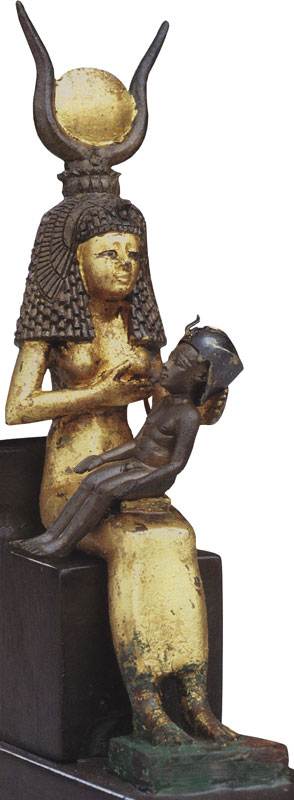 . As we have already said in CHRON1, ch.7:6.3, this is the way the artists of Egypt depicted Mother of God with the infant Christ. In fig.5.7
. As we have already said in CHRON1, ch.7:6.3, this is the way the artists of Egypt depicted Mother of God with the infant Christ. In fig.5.7 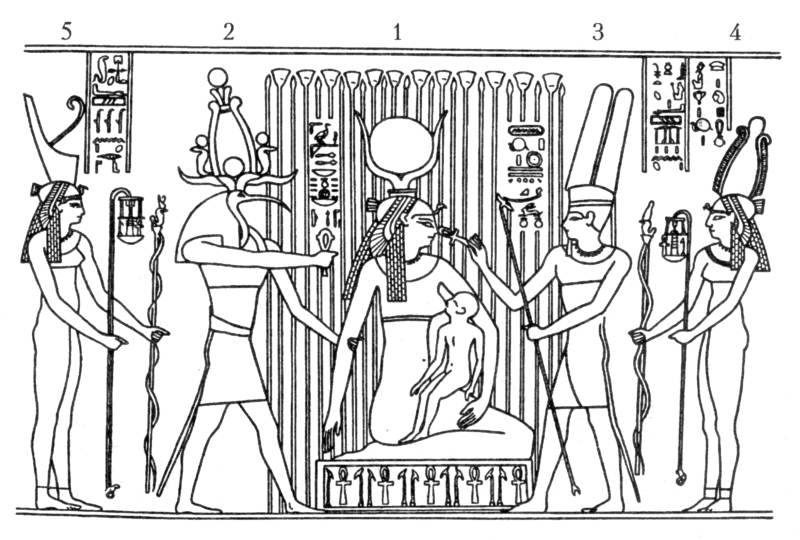 and fig. 5.8
and fig. 5.8 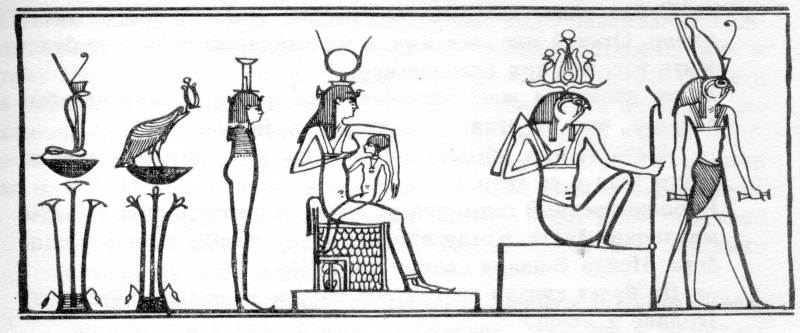 are presented two of the numerous ‘Ancient’ Egyptian pictures.
are presented two of the numerous ‘Ancient’ Egyptian pictures.
4. THE BIRTH OF CHRIST ‘FROM THE MAIDEN’S SIDE’ AND THE BIRTH OF THE EGYPTIAN GOD SET OR TYPHON FROM THE MOTHER’S SIDE.
In Christianity only Christ is born on the first days of Creation. But in the Egyptian texts, at least the way they are translated by the commentators, - there were born several gods at once. Who, in fact, all correspond with Christ. Thus there emerges a striking parallel with the Christian texts. We already said that according to the Old Russian Sunday service Christ was born from the Maiden’s side. The Egyptian papyrus says that ‘on the third day Typhon (i.e. Set) came into the world, but he was not born as it should be, when he was due, but CAME OUT HIS MOTHER’S SIDE FROM THE WOUND HE INFLICTED ON HER’[11], p.40.
Here the two Christian stories are mixed in one. Firstly, the Nativity of Christ ‘from the Maiden’s side’. Secondly, in the Christian service quite often there is recalled a Gospel maxim about Christ’s crucifixion causing a deep emotional wound to the Mother of God. It is literally says: ‘Yea, a sword shall pierce through thy own soul also’ (Luke 2:35). These words should be interpreted in the sense of an emotional wound. But on the other hand the Mother of God also endured a bodily wound during the birth of Christ via caesarean section. The two wounds could have mixed up, as we can see in the Egyptian papyrus. But the second spiritual wound was inflicted on the Mother of God by the one who crucified Christ. In the Egyptian version they referred to Typhon or Set = Satan. In the story of Andronicus-Christ it is Isaac Angelos, aka Satan in the Christian tradition. This is possibly the reason why the Egyptian source is speaking of the wound inflicted onto to the mother by Typhon = Set.
As we have seen above, see ch.2, in the ‘Ancient’ Greek myth about Zeus-Christ, similar to the Judaic texts CHRIST AS IT WERE GIVES BIRTH TO HIMSELF FROM THE HIP. We can also see literally the same motif in the ‘Ancient’ Egyptian version. Here we are informed that GOD HORUS (Christ?) WAS BORN FROM THE BODY OF OSIRIS [86], p.81. In fig.5.9 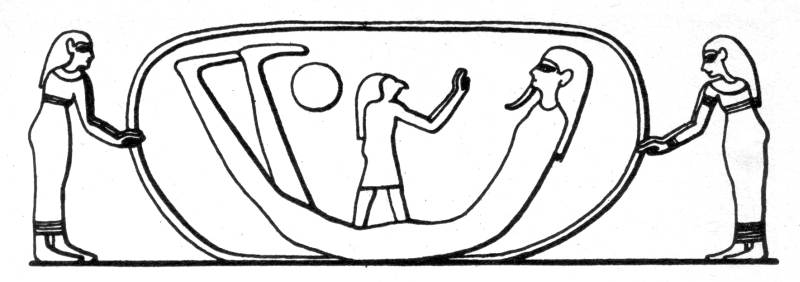 we present the corresponding Egyptian image – god Horus appears from Osiris’ hip or his side. It is likely after the incision, i.e. as a result of the caesarean section from his Mother’s side.
we present the corresponding Egyptian image – god Horus appears from Osiris’ hip or his side. It is likely after the incision, i.e. as a result of the caesarean section from his Mother’s side.
5. WEDNESDAY FAST AND THE EGYPTIAN FASTING ON THE ‘FAILED THIRD DAY’.
In Orthodox Christianity it is customary to fast every Wednesday to commemorate the betrayal by Judas. According to the Gospels Judas betrayed Christ on Wednesday. In the Christian Liturgy during Passion Week it is on Wednesday that Judas’ betrayal is remembered. On the other hand the Osiris Zodiac = Circular Denderah Zodiac gives the date of the 20 March 1185 which fell exactly on WEDNESDAY. Thus in the Egyptian tradition which the Osiris Zodiac belongs to, it was Wednesday which was marked as the date associated with Christ’s crucifixion. Such a custom is entirely understandable. After all it is on Wednesday the 20th March 1185 that the Easter week began during which took place all the Easter events associated with the crucifixion and the Resurrection of Christ.
For indeed from the Egyptian papyruses the modern commentators find that ‘the third of the ‘extra days’ considered to be Typhon’s Birthday, was considered by the kings of Egypt to be unlucky and therefore did not do any business on that day and ‘DID NOT CONSUME ANY WATER OR FOOD until the evening would fall’ [11], p.40. Incidentally the kings of Egypt used to fast on Wednesdays. To note, their fast was held according to the Muslim tradition (similar to the Christmas Eve). We ought to clarify here that Egyptian Typhon or Set represents the murderer of Andronicus-Christ. Aka Satan and to some extent Judas, see above. It fully corresponds with the fact, that the fasting on Wednesday was associated specifically with Judas, i.e. with the betrayal. The Egyptologists noted the following concerning Osiris: ’Deeply humane and understandable to everyone the image of the KIND KING TREACHEROUSLY BROUGHT DOWN BY HIS EVIL AND CUNNING BROTHER, who was avenged by the loving son of the murdered one, and also a moving story about the poor wife and mother Isis undoubtedly ensured the increase in popularity of these gods’ [86], p.49.
6. THE TRAVELS OF ANDRONICUS-CHRIST ARE THE TRAVELS OF OSIRIS IN THE DISTANT LANDS
We have already discussed in detail the travels of Christ and the travels of Andronicus. To recall, Andronicus-Christ being an undesirable contender to the royal throne, was forced to wander for a long time in the foreign lands. When finally he returned and occupied the throne he was soon murdered.
We read literally the same about Egyptian Osiris. The only difference is that Osiris is considered to be a king from the very beginning. He allegedly set off travelling voluntarily leaving the throne to his brother Typhon. But a similar theme resonates in the story of Andronicus. To recap, Andronicus believed that the throne belonged to him by birth. That is he, as it were, from the very beginning was the king, but not anointed. During his travels Andronicus, as we remember, enlightened many nations. Besides, Andronicus-Christ also reflected as Apostle Andrew the First Called. In the very word APOSTLE itself there is contained the meaning of the illumination and instruction.
It is said the following about Osiris: ‘After becoming the king of Egypt Osiris enlightened and instructed his people leading them out of poverty and barbarism. He taught the Egyptians to grow and to improve the fruit of the earth, gave them a basic code of laws that govern their lives, taught them to revere gods and religious worship (i.e. he established faith and the religious rules - Author). Later on following the same noble purpose HE TRAVELLED AROUND THE WORLD URGING PEOPLE TO ADOPT THE ORDER HE ESTABLISHED, without forcing them with weapons, but convinced them with reason, expressed in his hymns accompanied by the musical instruments … Following Osiris’ return Typhon succeeded in pursuing seventy two people to participate in the PLOT. Together with a certain Queen of Ethiopia called Aso (Isaac? – Author) … he designed a cunning plan to execute his plot’ [11], p.40-41. The plot was successful and Typhon murdered Osiris.
Incidentally here is described the formation of the Christian service based largely on hymns and the church music. It emphasizes the apostolic preaching of Osiris. I.e. the free-will conviction, but not by force of arms. On the whole this description perfectly corresponds with the main milestones of the biography of Andronicus-Christ: true-born king, a long exile, apostolic preaching to different nations, the return and soon after death by violence.
There is also noted Osiris’ legislative activity. Let us recall that when describing the reign of Andronicus-Christ Nicetas Choniates enthuses about the legislative activity of Andronicus, despite his negative attitude towards him overall.